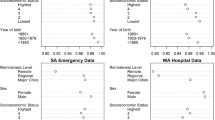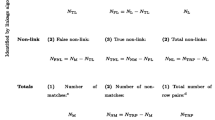Abstract
Objectives: Numerous studies have used maternally linked birth records to investigate perinatal outcomes, maternal behaviors, and the quality of vital records birth data. Little attention has been given to assessing errors in the linkages and to understanding how such errors affect estimates derived from the linked data. The author developed a framework for conceptualizing maternal linkage error and measures for quantifying it, and examined the behavior of the new measures in a maternally linked file. Methods: Linkage errors were conceptualized as misclassification, with the classes being the maternal sets (records classified as representing different births to the same woman). The true linkage proportion, analogous to sensitivity, was used to capture the degree to which all of a woman’s births were assigned to a single maternal set; the false linkage proportion, analogous to specificity, was used to capture the degree to which the assigned maternal sets combined births from different women. The behavior of the two proportions was examined by introducing increasing degrees of linkage error into a maternally linked file. Results: Both measures indicated greater misclassification with increasing simulated linkage errors. Conclusions: The new measures may be a useful tool for assessing the quality of maternally linked data, as well as other types of linked records where the linkages are within a single file. This is a necessary step towards developing methods for addressing misclassification bias in studies of maternally linked records through sensitivity analysis, adjustment, and other means.


Similar content being viewed by others
References
Herman AA, McCarthy BJ, Bakewell JM, Ward RH, Mueller BA, Maconochie NE, Read AW, Zadka P, Skjaerven R. Data linkage methods used in maternally-linked birth and infant death surveillance data sets from the United States (Georgia, Missouri, Utah and Washington State), Israel, Norway, Scotland and Western Australia. Paediatr Perinat Epidemiol 1997;11(Suppl 1):5–22.
Adams MM, Wilson HG, Casto DL, Berg CJ, McDermott JM, Gaudino JA, McCarthy BJ. Constructing reproductive histories by linking vital records. Am J Epidemiol 1997;145(4):339–48.
Adams MM, Elam-Evans LD, Wilson HG, Gilbertz DA. Rates of and factors associated with recurrence of preterm delivery. JAMA 2000;283(12):1591–6.
Adams MM, Delaney KM, Stupp PW, McCarthy BJ, Rawlings JS. The relationship of interpregnancy interval to infant birthweight and length of gestation among low-risk women, Georgia. Paediatr Perinat Epidemiol 1997;11(Suppl 1):48–62.
Bakewell JM, Stockbauer JW, Schramm WF. Factors associated with repetition of low birthweight: Missouri longitudinal study. Paediatr Perinat Epidemiol 1997;11(Suppl 1):119–29.
Doody DR, Patterson MQ, Voigt LF, Mueller BA. Risk factors for the recurrence of premature rupture of the membranes. Paediatr Perinat Epidemiol 1997;11(Suppl 1):96–106.
Holt VL, Danoff NL, Mueller BA, Swanson MW. The association of change in maternal marital status between births and adverse pregnancy outcomes in the second birth. Paediatr Perinat Epidemiol 1997;11(Suppl 1):31–40.
McGuire V, Rauh MJ, Mueller BA, Hickock D. The risk of diabetes in a subsequent pregnancy associated with prior history of gestational diabetes or macrosomic infant. Paediatr Perinat Epidemiol 1996;10(1):64–72.
Mueller BA, Schwartz SM. Risk of recurrence of birth defects in Washington State. Paediatr Perinat Epidemiol 1997;11(Suppl 1):107–18.
Schramm WF. Smoking during pregnancy: Missouri longitudinal study. Paediatr Perinat Epidemiol 1997;11(Suppl 1):73–83.
McDermott JM, Drews CD, Adams MM, Hill HA, Berg CJ, McCarthy BJ. Does inadequate prenatal care contribute to growth retardation among second-born African-American babies? Am J Epidemiol 1999;150(7):706–13.
Krulewitch CJ, Herman AA, Yu KF, Johnson YR. Does changing paternity contribute to the risk of intrauterine growth retardation? Paediatr Perinat Epidemiol 1997;11(Suppl 1):41–7.
Zhu BP, Le T. Effect of interpregnancy interval on infant low birth weight: a retrospective cohort study using the Michigan Maternally Linked Birth Database. Matern Child Health J 2003;7(3):169–78.
Beaty TH, Yang P, Munoz A, Khoury MJ. Effect of maternal and infant covariates on sibship correlation in birth weight. Genet Epidemiol 1988;5(4):241–53.
Yang P, Beaty TH, Khoury MJ, Liang KY, Connolly MA. Predicting intrauterine growth retardation in sibships while considering maternal and infant covariates. Genet Epidemiol 1989;6(4):525–35.
Cooperstock MS, Tummaru R, Bakewell J, Schramm W. Twin birth weight discordance and risk of preterm birth. Am J Obstet Gynecol 2000;183(1):63–7.
Dietz PM, Adams MM, Rochat RW, Mathis MP. Prenatal smoking in two consecutive pregnancies: Georgia, 1989–1992. Matern Child Health J 1997;1(1):43–51.
Elam-Evans LD, Adams MM, Delaney KM, Wilson HG, Rochat RW, McCarthy BJ. Patterns of prenatal care initiation in Georgia, 1980–1992. Obstet Gynecol 1997;90(1):71–7.
Green DC, Moore JM, Adams MM, Berg CJ, Wilcox LS, McCarthy BJ. Are we underestimating rates of vaginal birth after previous cesarean birth? The validity of delivery methods from birth certificates. Am J Epidemiol 1998;147(6):581–6.
Adams M. Validity of birth certificate data for the outcome of the previous pregnancy, Georgia,1980–1995. Am J Epidemiol 2001;154(10):883–8.
Greenland S. Basic methods for sensitivity analysis and external adjustment. In: Rothman KJ, Greenland S, editors. Modern Epidemiology. Lippincott Williams & Wilkins, Philadelphia; 1998;347–55.
Jaro MA. Probabilistic linkage of large public health data files. Stat Med 1995;14(5–7):491–98.
Sirard JR, Ainsworth BE, McIver KL, Pate RR. Prevalence of active commuting at urban and suburban elementary schools in Columbia, SC. Am J Public Health 2005;95(2):236–7.
Miller AB, Howe GR, Sherman GJ, Lindsay JP, Yaffe MJ, Dinner PJ, Risch HA, Preston DL. Mortality from breast cancer after irradiation during fluoroscopic examinations in patients being treated for tuberculosis. N Engl J Med 1989;321(19):1285–9.
Lash TL, Fink AK. Semi-automated sensitivity analysis to assess systematic errors in observational data. Epidemiology 2003;14(4):451–8.
Acknowledgements
The author thanks Drs. Russell Kirby and C. V. Ananth for comments on an earlier version of this paper. This study was funded in part by grants HD35785 from the National Institute of Child Health and Human Development, CA88757 from the National Cancer Institute, and UR6/CCU417428 from the National Center for Health Statistics.
Author information
Authors and Affiliations
Corresponding author
Appendix
Appendix
Linkage strategy for the maternally linked data set
The file was linked in three passes. All passes blocked on mother’s month of birth. In addition, pass 1 blocked on the soundex values of mother’s first and maiden names, pass 2 blocked on the soundex values of mother’s first and last names, and pass 3 blocked on the soundex values of mother’s last and middle names. The same value was used for the match and clerical review cutoff weights within a pass (i.e., clerical review was not performed). The values were 30.0, 20.0, and 35.0, respectively for passes 1, 2, and 3. The match specifications were identical for each pass and are given in the table above.
Rights and permissions
About this article
Cite this article
Leiss, J.K. A New Method for Measuring Misclassification of Maternal Sets in Maternally Linked Birth Records: True and False Linkage Proportions. Matern Child Health J 11, 293–300 (2007). https://doi.org/10.1007/s10995-006-0162-3
Received:
Accepted:
Published:
Issue Date:
DOI: https://doi.org/10.1007/s10995-006-0162-3




